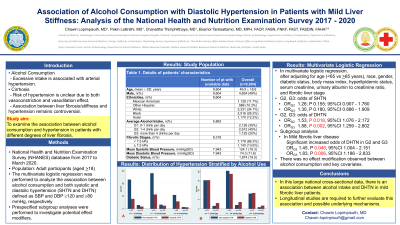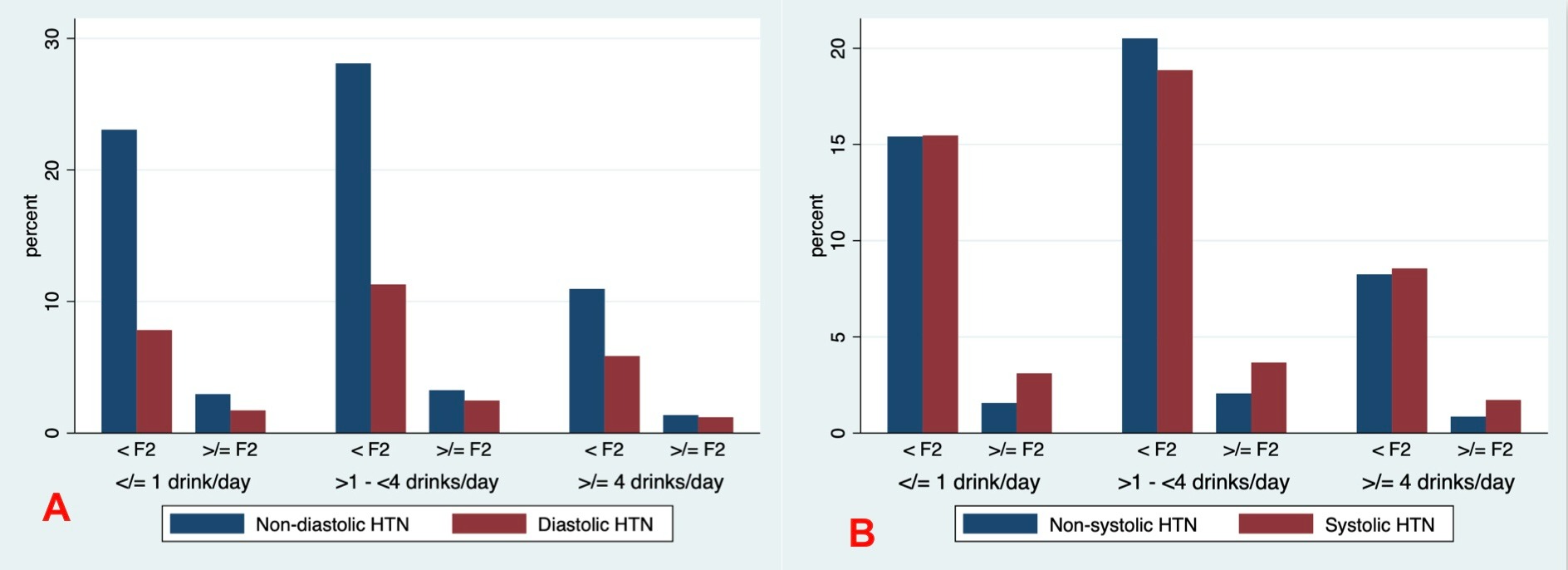Back


Poster Session A - Sunday Afternoon
Category: Liver
A0497 - Association of Alcohol Consumption With Diastolic Hypertension in Patients With Mild Liver Stiffness: Analysis of the National Health and Nutrition Examination Survey 2017-2020
Sunday, October 23, 2022
5:00 PM – 7:00 PM ET
Location: Crown Ballroom

Has Audio

Chawin Lopimpisuth, MD
King Chulalongkorn Memorial Hospital
Bangkok, Krung Thep, Thailand
Presenting Author(s)
Chawin Lopimpisuth, MD1, Pakin Lalitnithi, MD1, Chanattha Thimphitthaya, MD1, Ekamol Tantisattamo, MD2
1King Chulalongkorn Memorial Hospital, Bangkok, Krung Thep, Thailand; 2University of California Irvine School of Medicine, Orange, CA
Introduction: While excessive alcohol consumption is associated with arterial hypertension. Cirrhotic patient’s risk for hypertension remains unclear due to both vasodilatation and vasoconstriction effect. We aim to examine the association between alcohol consumption and hypertension in patients with different degrees of liver fibrosis.
Methods: A cross-sectional study using the National Health and Nutrition Examination Survey (NHANES) 2017 to March 2020 included adult participants. Association between alcohol consumption and both systolic and diastolic hypertension (SHTN and DHTN) defined as SBP and DBP ≥120 and ≥80 mmHg, respectively were analyzed by multivariate logistic regression. Prespecified subgroup analyses were performed to investigate potential effect modifiers.
Results: A total of 9,693 patients were identified (mean age 50+19 years old; 51% female; 35% white). Among the participants with Fibroscan results, they were stratified into 3 groups based on the number of alcohol drinks per day (0-1 drink per day (G1), 2,126 [36%]; 1-4 drinks per day (G2), 2,612 [45%]; > 4 drinks per day (G3), 1,125 [20%]). After controlling for age, race, gender, body mass index, diabetic status, hyperlipidemic status, serum creatinine, urinary albumin:creatinine ratio, and fibrotic liver stage (< F2 = mild and >F2 = significant with fibrosis scores of < 7.5 and >7.5 kPa, respectively), the G2 and G3 had greater the odds of having SHTN but not statistically significant. (ORG21.26; P 0.155; 95%CI 0.9076, 1.760; ORG3 1.30, P 0.180, 95%CI 0.886, 1.909). Both G2 and G3 were significantly more likely to develop DHTN (ORG2 1.53, P 0.018, 95%CI 1.076, 2.172; OR3G3 1.88, P0.002 95%CI 1.259, 2.802). Subgroup analysis revealed a significant increased odds of developing DHTN in G2 and G3 only for those with mild fibrosis (< F2; ORG2 1.45, P 0.048, 95%CI 1.004, 2.151; OR G3 1.83, P 0.006, 95%CI 1.186, 2.833). The magnitude and direction of the association were similar for participants with significant fibrosis (>F2; ORG21.64, P 0.363, 95%CI 0.566, 4.728; OR G3 1.86, P 0.308, 95%CI 0.564, 6.168; Figure 1A). The alcohol – SHTN association remains no statistical significance in all subgroups (Figure 1B). There was no effect modification observed between alcohol consumption and key covariates.
Discussion: In this study, there is an association between alcohol intake and DHTN in mild fibrotic liver patients. Longitudinal studies are required to further evaluate this association and possible underlying mechanisms.

Disclosures:
Chawin Lopimpisuth, MD1, Pakin Lalitnithi, MD1, Chanattha Thimphitthaya, MD1, Ekamol Tantisattamo, MD2. A0497 - Association of Alcohol Consumption With Diastolic Hypertension in Patients With Mild Liver Stiffness: Analysis of the National Health and Nutrition Examination Survey 2017-2020, ACG 2022 Annual Scientific Meeting Abstracts. Charlotte, NC: American College of Gastroenterology.
1King Chulalongkorn Memorial Hospital, Bangkok, Krung Thep, Thailand; 2University of California Irvine School of Medicine, Orange, CA
Introduction: While excessive alcohol consumption is associated with arterial hypertension. Cirrhotic patient’s risk for hypertension remains unclear due to both vasodilatation and vasoconstriction effect. We aim to examine the association between alcohol consumption and hypertension in patients with different degrees of liver fibrosis.
Methods: A cross-sectional study using the National Health and Nutrition Examination Survey (NHANES) 2017 to March 2020 included adult participants. Association between alcohol consumption and both systolic and diastolic hypertension (SHTN and DHTN) defined as SBP and DBP ≥120 and ≥80 mmHg, respectively were analyzed by multivariate logistic regression. Prespecified subgroup analyses were performed to investigate potential effect modifiers.
Results: A total of 9,693 patients were identified (mean age 50+19 years old; 51% female; 35% white). Among the participants with Fibroscan results, they were stratified into 3 groups based on the number of alcohol drinks per day (0-1 drink per day (G1), 2,126 [36%]; 1-4 drinks per day (G2), 2,612 [45%]; > 4 drinks per day (G3), 1,125 [20%]). After controlling for age, race, gender, body mass index, diabetic status, hyperlipidemic status, serum creatinine, urinary albumin:creatinine ratio, and fibrotic liver stage (< F2 = mild and >F2 = significant with fibrosis scores of < 7.5 and >7.5 kPa, respectively), the G2 and G3 had greater the odds of having SHTN but not statistically significant. (ORG21.26; P 0.155; 95%CI 0.9076, 1.760; ORG3 1.30, P 0.180, 95%CI 0.886, 1.909). Both G2 and G3 were significantly more likely to develop DHTN (ORG2 1.53, P 0.018, 95%CI 1.076, 2.172; OR3G3 1.88, P0.002 95%CI 1.259, 2.802). Subgroup analysis revealed a significant increased odds of developing DHTN in G2 and G3 only for those with mild fibrosis (< F2; ORG2 1.45, P 0.048, 95%CI 1.004, 2.151; OR G3 1.83, P 0.006, 95%CI 1.186, 2.833). The magnitude and direction of the association were similar for participants with significant fibrosis (>F2; ORG21.64, P 0.363, 95%CI 0.566, 4.728; OR G3 1.86, P 0.308, 95%CI 0.564, 6.168; Figure 1A). The alcohol – SHTN association remains no statistical significance in all subgroups (Figure 1B). There was no effect modification observed between alcohol consumption and key covariates.
Discussion: In this study, there is an association between alcohol intake and DHTN in mild fibrotic liver patients. Longitudinal studies are required to further evaluate this association and possible underlying mechanisms.

Figure: Figure 1: Distribution of diastolic (A) and systolic (B) hypertension stratified by the amount of alcohol consumption per day and the severity of liver fibrosis
Disclosures:
Chawin Lopimpisuth indicated no relevant financial relationships.
Pakin Lalitnithi indicated no relevant financial relationships.
Chanattha Thimphitthaya indicated no relevant financial relationships.
Ekamol Tantisattamo indicated no relevant financial relationships.
Chawin Lopimpisuth, MD1, Pakin Lalitnithi, MD1, Chanattha Thimphitthaya, MD1, Ekamol Tantisattamo, MD2. A0497 - Association of Alcohol Consumption With Diastolic Hypertension in Patients With Mild Liver Stiffness: Analysis of the National Health and Nutrition Examination Survey 2017-2020, ACG 2022 Annual Scientific Meeting Abstracts. Charlotte, NC: American College of Gastroenterology.
